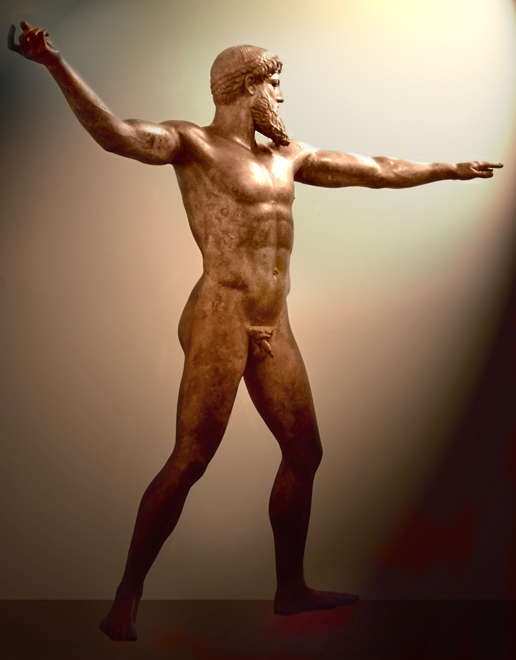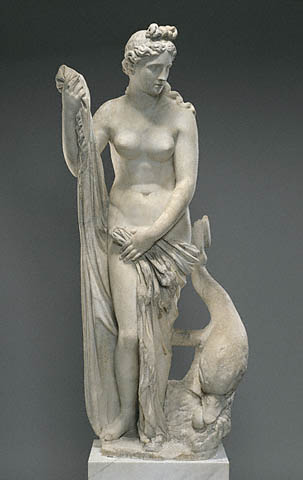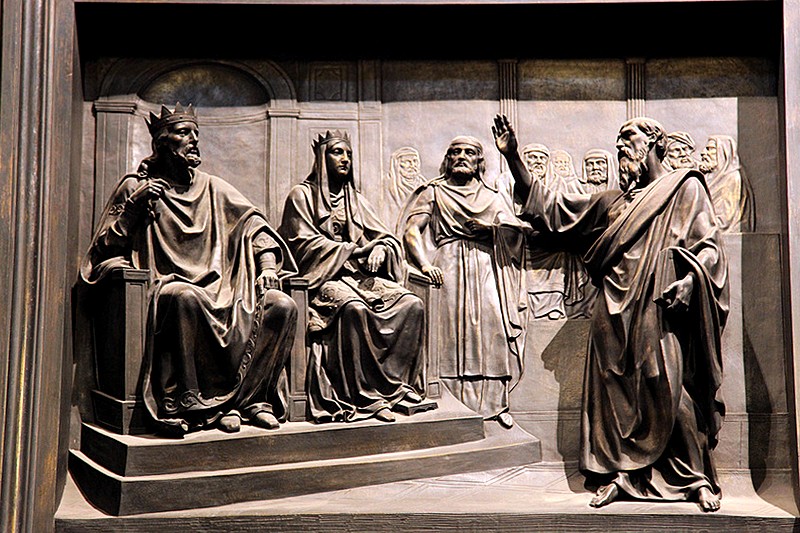Sculpture
When I mold a
piece of clay between my fingers the smell of the clay and its moist firmness
draw me in and invite me to creatively engage with the medium. As I view a
completed sculpture, its form and texture touches my soul in a way that paintings
cannot. The creating and viewing of a sculpture is an experience that envelops
the senses and ministers to the soul. I believe that sculptures touch people in
a way that no other area of the arts can capture. However, to fully appreciate
a sculpture, the formal and technical qualities of sculpture must be
understood. According to the author of Reality
Through the Arts, Dennis J. Sporre, the formal and technical qualities of
sculpture include the “dimensionality, methods of execution, [and] composition”
(67). In this blog I will be discussing the three forms of dimensionality,
which includes full-round, relief, and linear sculpture (Sporre 67).
Dimensionality
Before discussing
the three forms of dimensionality I need to identify what dimensionality means.
The English Oxford Dictionary defines dimensionality as being "a
measurable extent of some kind, such as length, breadth, depth, or height"
("Dimension"). In other words, dimensionality has to do with the
volume of the sculpture. According to Sporre, there are three terms used
to describe a sculpture's dimensionality; full-round, relief, and linear (67).
Each form of dimensionality comes with its own physical and structural
limitations, which may influence the sculptor’s decision to choose one type of
dimensionality over another (Sporre 67).
Full-round Sculptures
When I think of
full-round sculptures, I picture European style statues of gods or goddesses
and bust portraits of Roman kings. However, the definition of full-round
sculpture includes more sculptures than the classic European statues. Sporre
explains that “full-round works are freestanding and fully three-dimensional
[sculptures]…. intended to be viewed from any angle (67-68). In other words,
full-round means the sculpture can be viewed not only from the front, but also
the sides and back. Below are some examples of full round sculptures.
 |
| http://upload.wikimedia.org/wikipedia/commons/1/1a/Netuno19b.jpg |
| http://www.portraitartistforum.com/attachment.php?s=613ef26ef5c35387018636444bb43a5d&attachmentid=23607&stc=1&d=1252560944 |
 |
| http://image.made-in-china.com/2f0j00besatCDFlvkO/Modern-Sculpture-Moon-in-Love-18026-.jpg |
 |
| http://www.contemporist.com/photos/antony_gormley_block_works_04.jpg |
 |
| Private Collection: Created by Beth Nakatsui |
 |
| http://www.getty.edu/art/collections/images/l/00756201.jpg |
Sporre explains
that another limitation sculptors face when creating full-round works is that
of subject matter. It is difficult to create full-round sculptures of an
expansive countryside, a sunset, and the waves of the sea (68). Based on my
personal observations of fellow artists and sculptures I have viewed in art
museums, I have come to the conclusion that sculptors tend to avoid subject
matter that involves an expanse of empty space and far reaching masses. I find
that sculptors tend to create sculptures of objects, human beings, and animals
rather than landscapes and skyscapes. I have included two video clips below that show artists creating sculptures. The first video clip shows an artist creating a sculpture out of stone and the second shows an artist creating sculptures out of clay. These video clips will demonstrate how full-round sculptures are made.
http://www.youtube.com/watch?v=DWMzxhhSk98
http://www.youtube.com/watch?v=R1tH03sOhkU
Relief Sculptures
The second form of dimensionality that I will be discussing is relief and specifically how relief sculptures are similar or different from full-round sculptures. According to
Sporre a relief sculpture “… is three-dimensional... because it protrudes from a
background, [but it also] maintains a two-dimensional quality, as compared to
full-round sculpture” (69). Unlike a full-round sculpture, a relief sculpture
can only be viewed from the front. Because a relief sculpture has a background it easily allows for representations of skyscapes, landscapes, and representations
of large expanses (Sporre, 69). I believe that the main decision a sculptor must make when creating a
relief sculpture is the amount the sculpture will protrude. There are specific terms used to describe the amount of projection used in a relief sculpture but authors define these terms differently. Sporre says that a bas-relief also
known as a low relief protrudes slightly away from the background while a
haut-relief also known as a high relief protrudes about half or more of the
subject’s width (69). However, John W. Mills, author of The Technique of Sculpture, goes into more detail than Sporre and describes
three types of relief sculptures. According to Mills, there is a low relief that bearly
protrudes above the background, the bas-relief that protrudes “… as much as
half the volume of the form…” and the high relief also called alto relief and
is a sculpture that “… is using the complete form in the round, but keeping it
attached to the background” (15-16). However the types of reliefs are to be defines,
I believe the main point is that relief sculptures vary in the amount the
sculpture protrudes from the background. Below is a picture of the Western door
of St. Isaac’s Cathedral, which is a relief sculpture that demonstrates a
variety of levels of reliefs.
Below I have included a video clip that demonstrates how a relief sculpture is made using clay.
 |
| http://www.saint-petersburg.com/images/cathedrals/st-isaacs-cathedral/bas-relief-at-the-western-door-of-st-isaacs-cathedral-in-st-petersburg.jpg |
http://www.youtube.com/watch?v=qUEIdSsHRV0
Linear
When I think of
the words linear sculpture, I am inclined to think that it is an oxymoron. When
one defines the two words separately, the words seem to be opposites. According
to the English Oxford Dictionary, linear is defined as “ involving one
dimension only” and Sporre explains that sculpture is “a three-dimensional art”
(“Linear” and Sporre 67). So, the idea of a piece of art that is both one
dimensional and three-dimensional does not seem possible. However, linear
sculptures do exist. To understand what qualifies as a linear sculpture, I will
turn to Sporre for the definition. Sporre defines linear sculpture as those
sculptures that “… [emphasize] construction with linear items such as wire or
neon tubing” (70). In other words, linear sculptures are three-dimensional
objects that are made up of linear materials. The photograph presented below is
an example of a linear sculpture that was made by Kenneth Martin (“The
Collection”). Martin used two-dimensional materials including sheets of painted
metal and aluminum wire to create a mobile that takes up three-dimensions space
(“The Collection”).
Works
Cited
"Dimension." Def. 2. Oxford Dictionaries. Oxford University Press, 2013. Web. 29 Apr. 2013. <http://oxforddictionaries.com/us/definition/american_english/dimension?q=Dimensionality#dimension__29>.
"Linear." Def. 1b. Oxford Dictionaries. Oxford
University Press, 2013. Web. 29 Apr. 2013. <http://oxforddictionaries.com/us/definition/american_english/linear?q=linear>.
Mills, John W. The Technique of Sculpture. New York: Watson-Guptill Publications, 1976. Print.
Mills, John W. The Technique of Sculpture. New York: Watson-Guptill Publications, 1976. Print.
Sporre, Dennis J. Reality through the Arts. 8th ed. Boston:
Pearson Prentice Hall, 2013. Print.
"The Collection." Government Art Collection. Department
of Culture Media & Sport, n.d. Web. 29 Apr. 2013.
<http://www.gac.culture.gov.uk/work.aspx?obj=24179>.

Wow, it's so relaxing to see those pieces of sculptures, it looks real. For sure they used the nice quality of sculpture supply materials. Great work!
ReplyDeleteI'm curious if you have found or heard the term "Linear Sculpture" anywhere but in Sporre's book. Because I believe he just made it up and it's not a thing. Something could be described as such -- as linear-- BUT, it's not a normal term that is used, that I can find. Most of these Linear Sculptures could fit into broader characterizations...this is why I'm here, a search for "Linear Sculpture" on google, but all roads lead back to Sporre, unfortunately.
ReplyDelete